The cookiecutter shark takes its name because it leaves a cookie-shaped bite hole in its prey.
Advertisement
Cookiecutter Shark Scientific Classification
Read our Complete Guide to Classification of Animals.
Cookiecutter Shark Conservation Status
Cookiecutter Shark Facts
- Prey
- large squid, gonostomatids, crustaceans
- Group Behavior
- Solitary
- Fun Fact
- The cookiecutter shark takes its name because it leaves a cookie-shaped bite hole in its prey.
- Estimated Population Size
- Unknown
- Biggest Threat
- Ocean pollution
- Most Distinctive Feature
- Cookiecutter sharks glow
- Other Name(s)
- Cigar shark
- Habitat
- Ocean
- Predators
- large sharks and bony fish
- Diet
- Carnivore
- Favorite Food
- Marlin, tuna, other sharks, stingrays, seals and whales
- Type
- Dalatiidae
- Common Name
- Cigar shark
- Number Of Species
- 2
View all of the Cookiecutter Shark images!
Cookiecutter sharks are squaliform sharks.
Squaliform sharks have two dorsal fins. Squaliform sharks usually have five to seven gill slits on their sides. They also typically do not have anal fins.
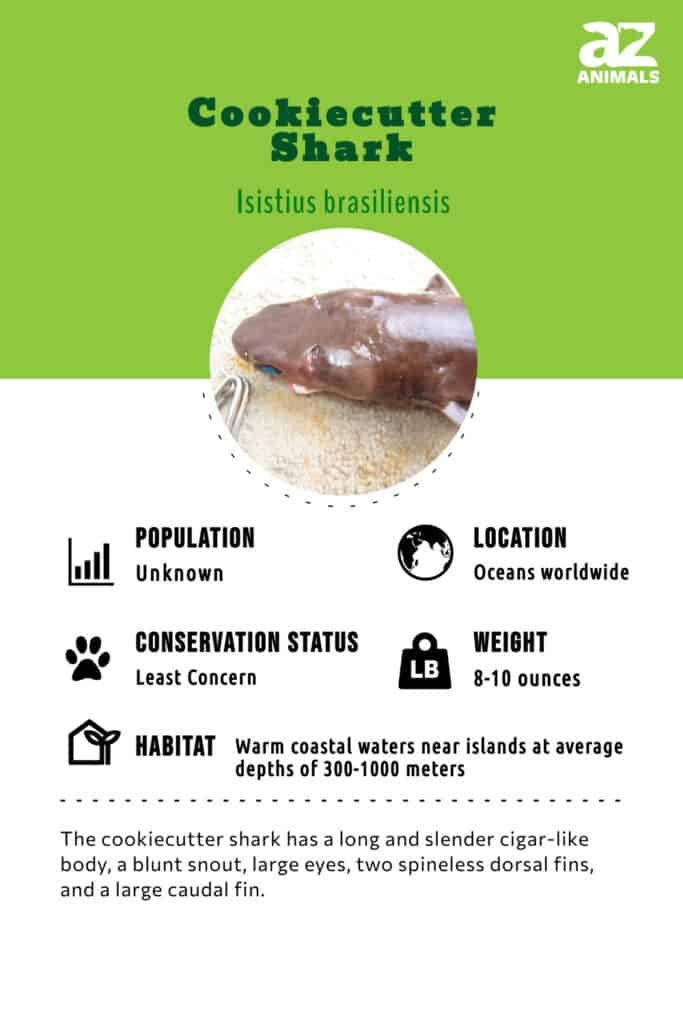
5 Incredible Cookiecutter Shark Facts
- These sharks have the largest teeth of any shark species at any location. Like all sharks, it loses its teeth and grows new ones throughout its life.
- The liver accounts for 35% of the sharks’ weight. The liver contains low-density lipids that help this shark float.
- The underside of the shark is covered in photophores that give this shark an eerie green glow. The glow lasts for up to 3 hours after the shark dies..
- These sharks are parasitic. They often bite out a cookie-shaped hole in a much larger fish.
- These sharks have bitten through submarines. They have bitten soft areas, like electrical cables and rubber sonar domes.
Classification and Scientific Name
The scientific name of the cookiecutter shark is Isistius brasiliensis. There are two species of cookiecutter sharks. The Isistius brasiliensis is called the cookiecutter shark while the Isistius plutodus is called the large cookiecutter shark. They are members of the Isistius genus.
All of these sharks are members of the Dalatiidae family. This family is more commonly referred to as the kitefin shark family. They are also members of the Squaliformes includes over 125 fish species. Like other fish with a spine primarily made of cartilage, they are part of the Chondrichthyes order. They belong to the Chordate phylum order and the Animalia kingdom.
Species
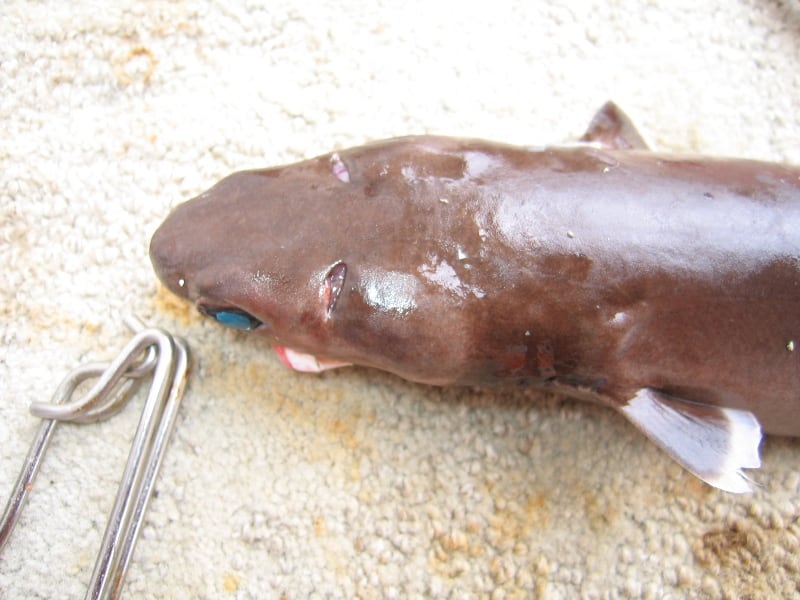
There are two species of cookiecutter shark–
Isistius brasiliensisand
Isistius plutodus
(large cookie-cutter shark).
©PIRO/NOAA Observer Program, Public domain, via Wikimedia Commons – Original / License
There are two species of these sharks. There have been only about 10 largetooth cookiecutter sharks caught, so very little is known about them.
Scientists believe that the largetooth cookiecutter shark has larger teeth, especially on the lower jaw, than the cookiecutter shark. They also think that the largetooth shark is a weaker swimmer than the cookiecutter shark. They both live in diverse locations globally.
Evolution
Like other shark species, experts believe that cookiecutter sharks evolved from ancestors in the Earth’s oceans more than 400 million years ago. They are classified Dalatiidae, the dogfish shark family, which is a primitive species. Cookiecutter sharks date back at least 100 million years.
Appearance
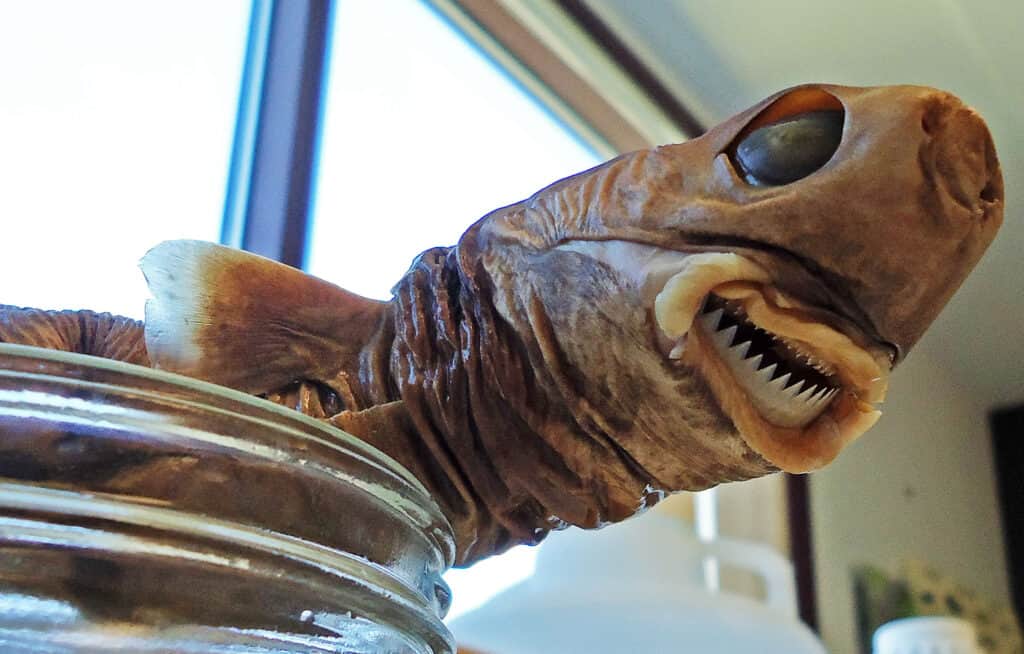
Cookiecutter sharks have long, slender bodies similar to a cigar shape, earning them the nickname ‘cigar shark.’
These sharks are light brown. It has a long slender shape, like a cigar, which is why it is often called the cigar shark. This shark has a short, blunt snout and large eyes. It has two spineless dorsal fins and a large caudal fin.
Covering the shark’s underside are photophores. This makes the fish appear to glow when viewed from the bottom. It will continue to glow for about 3 hours after the shark is dead.
Female sharks are larger than males in size. The average male is 14 inches long while the average female is 16 inches long.
Distribution, Population, and Habitat
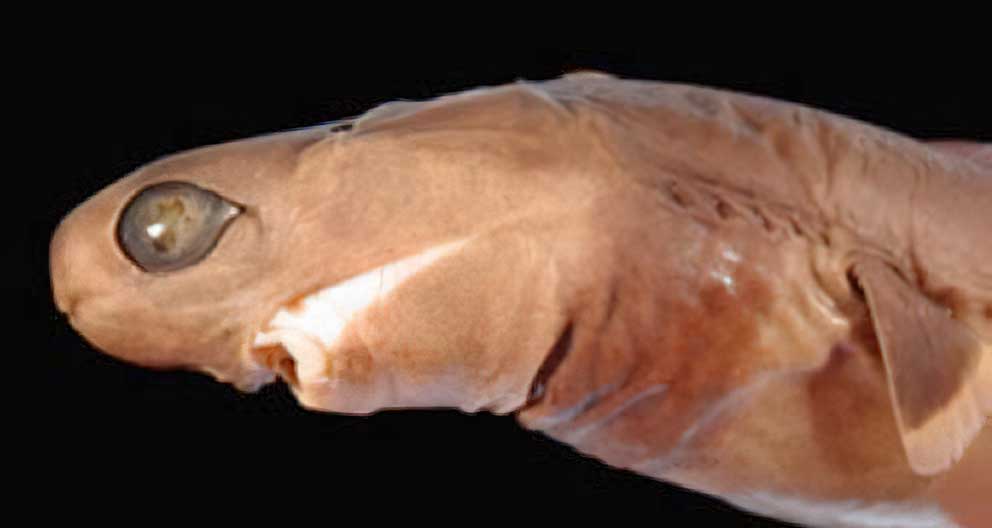
Cookiecutter sharks are listed as “least concern” by the IUCN.
©Karsten Harte / public domain / Wikimedia Commons – Original / License
These sharks are found throughout the world. Their habitat is coastal areas near islands, typically warm, deeper waters during the day, keeping below 1000 meters in day hours, but have been found as deep as 3500 meters. They migrate to more shallow waters at night at a depth of around 300 meters.
The International Union for Conservation of Nature lists this species as a species of least concern. There are no accurate numbers of how many of these sharks are in locations around the world.
Predators and Prey
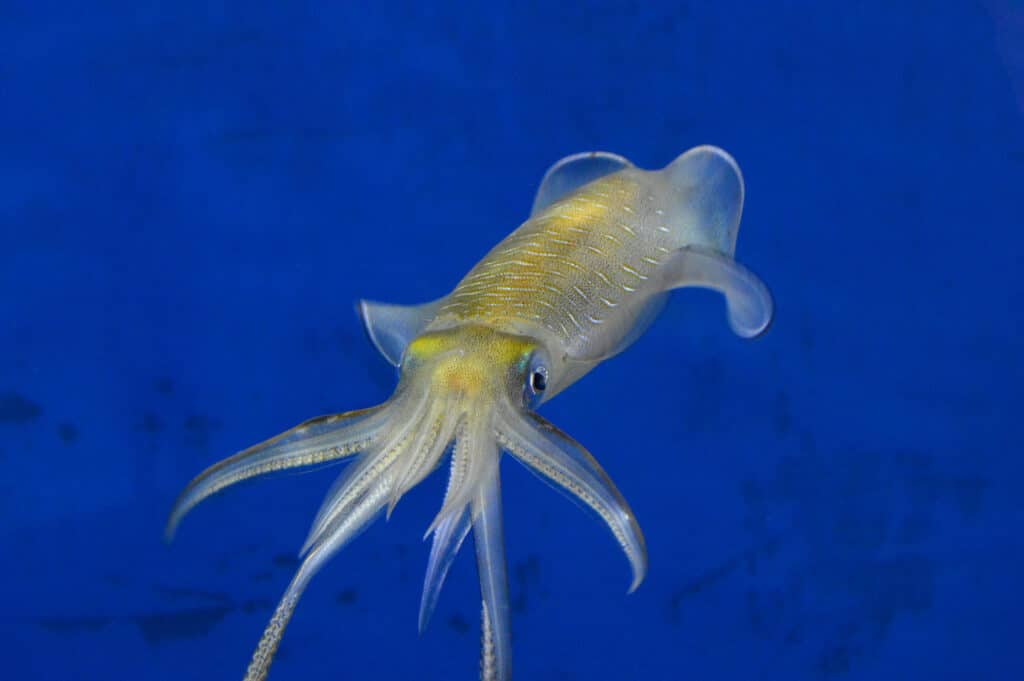
A cookiecutter shark has the ability to swallow a squid whole.
©iStock.com/kororokerokero
The cookie-cutter shark will prey on almost any marine living creature. It closes its suctorial lips against the prey, kind of like kissing it. Then, it uses its upper pointed teeth and powerful jaws to grip the prey better. Finally, it uses its upper teeth and jaws to take a chunk out of the animal. Most bites from the teeth and jaws measure about 2 inches across and 2.75 inches tall.
Many different animals have been spotted with this shark’s marks on their bodies, including porpoises, dolphins, whales, seals, sharks, stingrays, and bony fish.
Additionally, these sharks have eaten squid as big as themselves. They swallow these animals whole.
Reproduction and Lifespan
Scientists are not sure how long the gestation period is in these sharks. A shark baby is called a pup. They live inside the mother’s uterus. Six-to-12 pups are born as a baby at the same time, with each one measuring between 5.5-and-5.9 inches long when they are born. Each baby is in a sizable sac, so scientists theorize that this shark has a long gestation period.
Even though they may end up with a piece of their bodies missing, some animals eat these sharks. These animals include bony fish and sharks that are larger than them.
Fishing and Cooking
Except for a few caught accidentally, these sharks are not targeted by recreational or commercial anglers.
Population
No one has an accurate count of the number of these sharks.
View all 235 animals that start with CCookiecutter Shark FAQs (Frequently Asked Questions)
What Is a Cookiecutter Shark?
A cookiecutter shark is a shark that looks like a cigar that is about 14-22 inches long. These sharks are unique because they bite marine life that is much bigger than themselves. When they bite, they leave a distinctive cookie-cutter shape.
Are Cookiecutter Sharks Dangerous?
There have been very few cookiecutter shark attacks on humans. Part of the reason for the lack of attacks is that they spend most of their day about 2.3 miles under the ocean’s floor.
Cookiecutter sharks can be dangerous to other items. For example, they have been known to attack nuclear submarines. In that case, they tried to eat rubber hosing and cords.
Cookiecutter sharks can also be dangerous to other marine life. They are parasite sharks that use their strong mouths and jaws to attach themselves to even bigger animals than themselves. Then, they use their teeth to tear off pieces. The result is a hole that looks like it has been cut with a cookie-cutter.
Do Cookiecutter Sharks Eat Their own Teeth?
Yes, cookiecutter sharks eat their teeth. About 27 of the teeth come out as a unit regularly. Then, the shark swallows them. Some scientists believe that the shark swallows its teeth for the calcium in them because the water where they live may be poor in nutrients.
The cookiecutter shark then regrows their teeth, and the process happens all over again.
Can a Cookiecutter Shark Bite Through a Submarine?
No, cookiecutter sharks cannot bite through the shell of a submarine. They can harm submarines in other ways. For instance, they have been reported eating rubber and other soft materials outside the submarine.
What Eats a Cookiecutter Shark?
Although they may get bitten in the process, larger sharks and large bony fish eat cookiecutter sharks.
What Does a Cookiecutter Shark Look Like?
The cookiecutter shark has a cigar shape. Most of their bodies are brown, but they have a distinct vertical stripe that is a lighter brown. Additionally, there is lighter brown around their gill area.
The ventral area of this shark is covered with photophores that produce a greenish glow on the shark’s belly. Pale margins are found on all the fins, except the caudal fin. This fin has a dark tip.
How big Is a Cookiecutter Shark?
A cookiecutter shark grows to be between 14-and-22-inches long. Females are about 20% bigger than males.
Thank you for reading! Have some feedback for us? Contact the AZ Animals editorial team.
Sources
- Fishbase / Accessed July 3, 2021
- We Love Sharks / Accessed July 3, 2021
- Wikipedia / Accessed July 3, 2021
- Mentalfloss / Accessed July 3, 2021
- Wonderopolis / Accessed July 3, 2021
- Florida Museum / Accessed July 3, 2021
- Shark Keeper / Accessed July 3, 2021


















